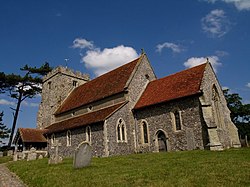Beddingham
| Beddingham | |
| Sussex | |
|---|---|
 Beddingham Church | |
| Location | |
| Grid reference: | TQ445078 |
| Location: | 50°51’6"N, 0°3’7"E |
| Data | |
| Population: | 242 (2011) |
| Post town: | Lewes |
| Postcode: | BN8 |
| Dialling code: | 01273 |
| Local Government | |
| Council: | Lewes |
| Parliamentary constituency: |
Lewes |
Beddingham is a village in Sussex, standing at the junction between the London–Newhaven (A26) and south coast (A27) roads south-east of Lewes.
The parish population was recorded as 289 in the 2001 census and 242 in the 2011 census.
History
Many tumuli are found in the surrounding hills originating in the Iron Age.
The Roman villa at Beddingham (50°50’52"N, 0°4’16"E was excavated in 1989 to 1992. Construction began in the late first century AD, and the villa was occupied until the mid fourth-century. There was a wooden roundhouse built originally (about 50 AD) before Roman construction began towards the end of the century.[1]
When the Saxons came, one of the buildings on the site was hollowed out for a typical early Saxon cellar. The fill of the cut contains a mix of Late Roman and Early Saxon pottery, suggesting some degree of continuity of settlement.[2]
Beddingham was a Saxon royal minster. It was probably seized by Offa of Mercia after his annexation of Sussex early in the 770s.[3] One of Offa's coins was found there.[4] After the Viking invasions, when Sussex had fallen to the West Saxons, the land was bequeathed by King Alfred to his nephew Æthelhelm. Before the Conquest, the manor was held by Godwin, Earl of Wessex.
The manor of Preston in Beddingham (or "Preston Becklewin") was originally held by the Abbey of Bec and passed to King's College, Cambridge, on its foundation.[5]
The original church was wooden. The Normans used local flint from the South Downs to construct the present building. The noted horticulturist Frances Garnet Wolseley, 2nd Viscountess Wolseley was buried in the churchyard in 1936.
The 13th-century Itford Farm house (Grade II* listed) was converted into the YHA South Downs youth hostel in 2013.[6]
Landscape
There are two 'Sites of Special Scientific Interest' within the former parish.
- Firle Escarpment,[7] which extends into the neighbouring parish of Firle.
- Asham Quarry,[8] which is said to be of geological interest due to its stratigraphy of Devensian and Flandrian deposits.
The track that runs from Little Dene up to the Firle Escarpment was laid down as a tank road during the Second World War. This was intentionally abandoned after the war, although it is still used by farm vehicles.[9]
Culture
Virginia Woolf spent holidays and weekends during 1912–19 at Asham House, just off the road between Lewes and Newhaven. The house was later surrounded by the cement works that opened in 1932 and became derelict. The Grade II listed house was demolished on 12 July 1994, to allow expansion of Beddingham landfill site.[10]
Peggy Angus rented Furlongs, a cottage beneath the South Downs, to host a circle of artistic friends, including Eric Ravilious, Tirzah Garwood and John Piper. Ravilious was notably inspired by the landscape to produce some of his famous work, such as Tea at Furlongs.
Industry
An experimental flotation kiln was built into the face of Asham Quarry in 1928. In 1927 the chemist Geoffrey Martin had patented a kiln designed to enable cement to be manufactured more cheaply.[11] The experimental kiln to the patented design was constructed by hand. The experiments lasted three months in late 1929.[12] The kiln was demolished when the quarry was converted into Beddingham landfill site.
Rodmell Works was founded as a cement works with a rotary kiln in 1932, adjacent to Asham Quarry, using a two-ffot narrow-gauge tramway. Cement was carried to Asham Wharf on the Ouse by an aerial ropeway and there loaded into boats piloted up and down the Ouse by tugs. Clay from Piddinghoe and coal for the kilns were shipped in. The works closed in 1975.
Outside links
| ("Wikimedia Commons" has material about Beddingham) |
References
- ↑ Russell, M., 2006: Roman Sussex. Tempus. pp. 166–169.
- ↑ M. Russell, 2006: Roman Sussex. Tempus. p. 205.
- ↑ Combes, Pamela (2002). "Bishopstone, a pre-Conquest minster church". Sussex Archaeological Collections 140: 49–56. doi:10.5284/1085743.
- ↑ 1911 Encyclopædia Britannica article on Sussex.
- ↑ King's College Estates Records, King's College Archive Centre, Cambridge.
- ↑ BBC News. Retrieved 12 September 2019.
- ↑ SSSI listing and designation for Firle Escarpment
- ↑ SSSI listing and designation for Asham Quarry
- ↑ Longstaff-Tyrrell, P., 1998: Tyrrell's List: the Artefacts of Two Great Wars in Sussex.
- ↑ Asham Award
- ↑ Geoffrey Martin, British Patent No. 276.066 (application date 17 May 1926; complete acceptance date 17 August 1927)
- ↑ R. G. Martin, 1992: "Experimental Cement Shaft Kiln at Beddingham", Sussex Industrial History pp. 21–35.